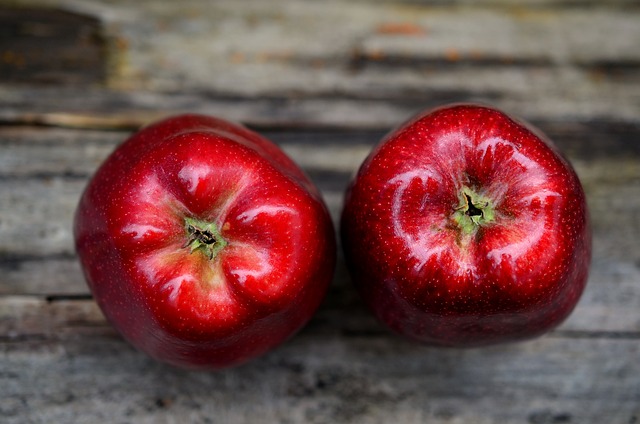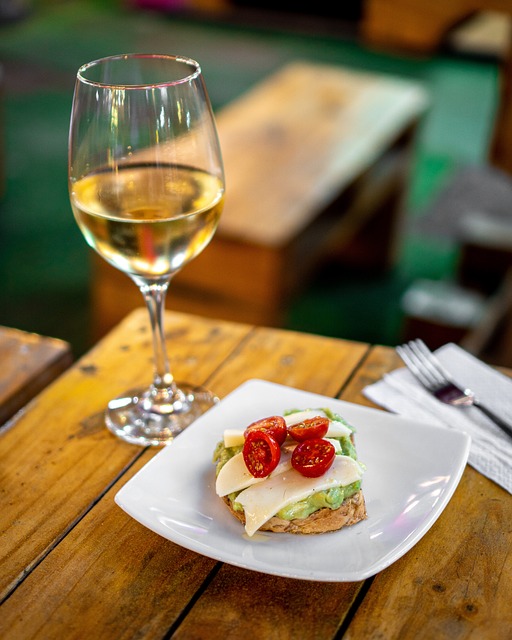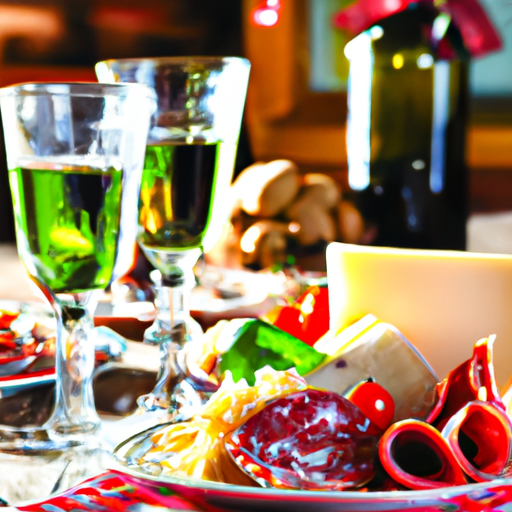Do you ever feel confused about which wine to pair with your favorite foods? Don’t worry, you’re not alone! Choosing the right wine to enhance the flavors of a meal can be tricky, but it doesn’t have to be. In this article, we’ll discuss the essential food and wine pairing chart that will help you navigate the world of food and wine pairings with ease.
When it comes to food and wine pairings, there are a few key principles that you should keep in mind. First and foremost, it’s all about balancing the flavors. You want the wine to complement the dish, not overpower it. For example, if you’re enjoying a rich and creamy pasta dish, a full-bodied red wine like a Cabernet Sauvignon or a Syrah would be a great choice. The robust flavors of the wine will stand up to the richness of the dish and create a harmonious pairing.
Another important factor to consider is the acidity of both the food and the wine. It’s generally a good idea to match the acidity levels of the food and the wine. For acidic dishes like citrus-based salads or tomato-based pasta sauces, a crisp white wine like a Sauvignon Blanc or a Pinot Grigio would be a perfect match. On the other hand, if you’re indulging in a juicy steak or a charred burger, a bold and tannic red wine like a Cabernet Sauvignon or a Malbec would be ideal.
In the next part of this article, we’ll dive deeper into the food and wine pairing chart and explore different types of cuisine and the wines that pair best with them. Stay tuned to discover the perfect wine for your favorite dishes, and elevate your dining experience to a whole new level.
Understanding Food and Wine Pairing
When it comes to enjoying a meal, choosing the right wine can greatly enhance your dining experience. The art of food and wine pairing involves selecting a wine that complements and enhances the flavors of the dish you are enjoying. By understanding the principles and guidelines behind food and wine pairing, you can create harmonious combinations that will tantalize your taste buds and leave you wanting more.
Taste and Sensory Experience
One of the key aspects of food and wine pairing is understanding the different tastes and sensory experiences that each brings to the table. Wine can have a range of flavors, including fruity, floral, earthy, and spicy notes, while food can be sweet, salty, sour, or savory. By considering these flavor profiles, you can create a balance and harmony between the two. For example, a fruity and aromatic white wine can complement a dish with subtle flavors, while a bold and spicy red wine can stand up to rich and intense flavors.
Another important aspect of food and wine pairing is considering the sensory experience of both the wine and the food. Pay attention to the body of the wine – is it light and crisp or full-bodied and rich? This can help you determine whether it will pair well with lighter or heavier dishes. Similarly, consider the texture of the food – is it creamy, crunchy, or tender? This can also guide you in selecting a wine that will complement the texture of the dish.
Principles and Guidelines
While there are no hard and fast rules when it comes to food and wine pairing, there are some general principles and guidelines that can help you make informed choices. Here are a few tips to keep in mind:
-
Match the intensity: Try to match the intensity of the wine with the intensity of the dish. A bold and robust dish will generally pair better with a full-bodied wine, while a lighter and more delicate dish will pair well with a lighter wine.
-
Balance the flavors: Look for complementary flavors in the wine and the food. For example, a wine with citrusy notes can pair well with a seafood dish that has a squeeze of lemon.
-
Consider the cooking method: The cooking method can greatly influence the flavors of a dish. Grilled or roasted meats can pair well with a wine with smoky or earthy undertones, while steamed or poached seafood can be complemented by a crisp and acidic white wine.
-
Think about regional pairings: Certain wines are traditionally paired with specific regional cuisines. For example, Italian wines like Chianti or Barbera are often paired with tomato-based dishes, while French wines like Bordeaux or Burgundy can enhance the flavors of rich and indulgent dishes.
Common Mistakes to Avoid
While pairing food and wine can be a delightful experience, there are some common mistakes that can hinder the enjoyment of your meal. Here are a few mistakes to avoid:
-
Overpowering the flavors: Be careful not to choose a wine that overpowers the flavors of the dish. If the wine is too strong or bold, it can mask the delicate flavors of the food.
-
Clashing flavors: Some flavors simply do not work well together. Avoid pairing a wine with strong tannins with a dish that is already high in tannins, as it can create an unpleasant and astringent sensation in your mouth.
-
Ignoring personal preferences: While there are general guidelines to follow, ultimately, the best pairings are the ones that you enjoy. Don’t be afraid to experiment and trust your own taste buds.
Pairing Wine with Appetizers and Light Dishes
Appetizers and light dishes are usually the first course of a meal, and they set the tone for what is to come. When it comes to pairing wine with these dishes, there are a few key considerations to keep in mind.
Cheese and Wine Pairings
Cheese is a popular choice for appetizers, and it can be paired with a wide range of wines. The key to a successful cheese and wine pairing is to consider the intensity and flavor profile of the cheese.
For example, a creamy and mild cheese like Brie or Camembert pairs well with a light and crisp white wine such as Sauvignon Blanc or Chardonnay. The acidity of the wine cuts through the richness of the cheese, while the creaminess of the cheese enhances the texture of the wine.
On the other hand, a strong and aged cheese like Parmesan or Gorgonzola pairs well with a bold and robust red wine such as Cabernet Sauvignon or Syrah. The strong flavors of the cheese stand up well to the intense flavors of the wine, creating a harmonious combination.
Seafood and Wine Pairings
Seafood dishes can vary greatly in flavor and intensity, so it is important to choose a wine that complements the specific dish you are enjoying.
For light and delicate seafood dishes such as oysters or shrimp cocktail, a crisp and acidic white wine like Chablis or Sauvignon Blanc is a great choice. The citrusy and mineral notes of the wine enhance the natural flavors of the seafood.
For more flavorful and rich seafood dishes like grilled salmon or lobster, a medium-bodied white wine like Chardonnay or Viognier can be a good match. The buttery and oaky flavors of the wine complement the richness of the dish.
Vegetarian and Vegan Options
For those who prefer vegetarian or vegan options, there are plenty of wine pairing choices to explore. When pairing wine with vegetarian dishes, it is important to consider the flavors and textures of the ingredients.
For light and fresh vegetable dishes, a light and crisp white wine like Pinot Grigio or Riesling can be a refreshing choice. The fruity and floral notes of the wine enhance the natural sweetness of the vegetables.
For heartier and more flavorful vegetarian dishes like mushroom risotto or vegetable curry, a medium-bodied red wine like Pinot Noir or Merlot can be a great match. The earthy and spicy flavors of the wine complement the depth of the dish.

Pairing Wine with Main Courses
After enjoying appetizers and light dishes, it’s time to move on to the main course. Whether you are serving red meat, poultry, or fish, there are wine pairing options to suit every taste and preference.
Red Meat and Wine Pairings
Red meat dishes, such as steak or roast beef, are known for their robust flavors and rich textures. When it comes to pairing wine with red meat, bold and full-bodied red wines are the way to go.
For a classic pairing, choose a Cabernet Sauvignon or a Bordeaux blend. These wines have intense flavors of dark fruits and spice, which pair well with the richness of the meat.
For a more unique pairing, try a Syrah or a Zinfandel. These wines have a bolder and more peppery flavor profile, which can complement the charred and smoky flavors of grilled or barbecued meats.
Poultry and Wine Pairings
Poultry dishes, such as roasted chicken or turkey, have a milder flavor compared to red meat. When pairing wine with poultry, it’s important to choose a wine that won’t overpower the delicate flavors of the meat.
For white meat like chicken or turkey, a medium-bodied white wine like Chardonnay or Pinot Gris can be a great choice. These wines have enough body and flavor to stand up to the meat without overpowering it.
For more flavorful poultry dishes like roast duck or Cornish game hen, a light-bodied red wine like Pinot Noir or Gamay can be a wonderful match. The fruity and earthy flavors of the wine complement the richness of the meat.
Fish and Seafood Pairings
Fish and seafood dishes can range from light and delicate to rich and flavorful. When pairing wine with fish and seafood, it’s important to consider the intensity and flavor profile of the dish.
For light and mild fish dishes like grilled halibut or poached sole, a light and crisp white wine like Sauvignon Blanc or Chenin Blanc is a good choice. The acidity of the wine cuts through the richness of the fish, while the citrusy flavors complement the natural flavors of the seafood.
For more flavorful and rich seafood dishes like pan-seared scallops or lobster thermidor, a medium-bodied white wine like Chardonnay or Viognier can be a great match. The buttery and oaky flavors of the wine complement the richness of the dish.
Pairing Wine with Spicy and Ethnic Dishes
Spicy and ethnic dishes can present a unique challenge when it comes to wine pairing. The heat and bold flavors of these dishes can overpower certain wines, so it’s important to choose a wine that can stand up to the spice.
Mexican and Latin American Cuisines
Mexican and Latin American cuisines are known for their bold and spicy flavors. When pairing wine with these dishes, opt for wines with some sweetness and lower levels of tannins.
For spicy dishes like enchiladas or tacos, a semi-sweet white wine like Riesling or Gewürztraminer can be a great choice. The sweetness of the wine helps to balance the heat of the spices.
For rich and flavorful dishes like mole or carne asada, a medium-bodied red wine like Malbec or Carmenere can be a good match. The fruity and spicy flavors of the wine complement the complexity of the dish.
Indian and Asian Cuisines
Indian and Asian cuisines are known for their aromatic spices and bold flavors. When pairing wine with these dishes, it’s important to choose wines with a good balance of acidity and fruitiness.
For spicy Indian dishes like curry or vindaloo, a fruity and slightly sweet white wine like Gewürztraminer or Riesling can be a great match. The sweetness of the wine helps to tame the heat of the spices and enhance the flavors of the dish.
For Asian dishes like stir-fry or sushi, a dry and aromatic white wine like Sauvignon Blanc or Pinot Gris can be a good choice. The crisp acidity and citrusy flavors of the wine complement the freshness of the ingredients.
Middle Eastern and Mediterranean Flavors
Middle Eastern and Mediterranean cuisines are known for their bold flavors and use of spices like cumin and coriander. When pairing wine with these dishes, it’s important to choose wines with good acidity and flavors that can stand up to the spices.
For dishes like falafel or tabbouleh, a dry and fruity white wine like Sauvignon Blanc or Vermentino can be a great choice. The acidity of the wine helps to cut through the richness of the dishes.
For grilled or roasted meats like kebabs or lamb chops, a medium-bodied red wine like Syrah or Tempranillo can be a good match. The fruity and earthy flavors of the wine complement the smoky flavors of the dish.

Pairing Wine with Desserts and Cheese
No meal is complete without a sweet ending, and pairing wine with desserts can be a delightful experience.
Sweet and Fortified Wines
When it comes to pairing wine with sweet desserts, it’s important to choose a wine that is sweeter than the dessert itself. This helps to balance the sweetness and prevent the wine from tasting flat.
For light and fruity desserts like fruit tarts or sorbets, a sparkling wine like Moscato d’Asti or Prosecco can be a great choice. The bubbly and fruity flavors of the wine enhance the freshness of the desserts.
For rich and indulgent desserts like chocolate cake or crème brûlée, a fortified wine like Port or Sherry can be a wonderful match. The sweetness and depth of these wines complement the richness of the desserts.
Chocolate and Wine Pairings
Pairing wine with chocolate can be a match made in heaven, but it’s important to choose the right wine to complement the flavors of the chocolate.
For dark chocolate desserts or truffles, a full-bodied red wine like Cabernet Sauvignon or Zinfandel can be a great choice. The bold flavors of the wine stand up to the intensity of the chocolate.
For milk chocolate desserts or chocolate-covered fruits, a sweet and fruity red wine like Merlot or Lambrusco can be a good match. The sweetness of the wine enhances the creaminess of the chocolate.
Cheese and Wine Combinations
Cheese is often enjoyed as a dessert course, and pairing it with the right wine can elevate the flavors of both.
For mild and creamy cheeses like Brie or Camembert, a crisp and acidic white wine like Sauvignon Blanc or Chardonnay can be a great match. The acidity of the wine cuts through the richness of the cheese, while the creaminess of the cheese enhances the texture of the wine.
For stronger and aged cheeses like blue cheese or aged cheddar, a bold and robust red wine like Cabernet Sauvignon or Syrah can be a wonderful match. The strong flavors of the cheese stand up well to the intense flavors of the wine, creating a harmonious combination.
Pairing Wine with Vegetarian and Vegan Dishes
With the increasing popularity of vegetarian and vegan diets, it’s important to consider wine pairing options for these dishes as well.
Alternative Protein Sources
When it comes to vegetarian and vegan dishes, there are plenty of alternative protein sources to choose from, such as tofu, tempeh, and seitan. These ingredients have unique textures and flavors, and the right wine pairing can enhance their taste.
For dishes with grilled tofu or tempeh, a light and fruity red wine like Pinot Noir or Gamay can be a great match. The fruity and earthy flavors of the wine complement the grill marks and smokiness of the proteins.
For dishes with seitan or other meat substitutes, a medium-bodied red wine like Merlot or Cabernet Franc can be a good choice. The tannins and flavors of the wine can stand up to the richness and heartiness of the proteins.
Flavor Profiles and Wine Selection
When it comes to pairing wine with vegetarian and vegan dishes, it’s important to consider the flavors and textures of the ingredients.
For light and fresh vegetable dishes, a light and crisp white wine like Pinot Grigio or Sauvignon Blanc can be a refreshing choice. The fruity and floral notes of the wine enhance the natural sweetness of the vegetables.
For heartier and more flavorful vegetarian dishes like mushroom risotto or vegetable curry, a medium-bodied red wine like Merlot or Syrah can be a great match. The earthy and spicy flavors of the wine complement the depth of the dish.

Exploring Regional Wine Pairings
One way to enhance your food and wine pairing experience is to explore regional pairings. Certain wines are traditionally paired with specific regional cuisines, and these combinations can create a harmonious and authentic dining experience.
Italian Wine and Food Pairings
Italian cuisine is known for its rich and diverse flavors, and there are countless wine pairing options to explore. Some traditional Italian wine and food pairings include:
- Chianti with tomato-based pasta dishes like spaghetti Bolognese or lasagna
- Prosecco with antipasti like bruschetta or caprese salad
- Barolo with rich and savory dishes like osso buco or mushroom risotto
- Amarone with aged or strong cheeses like Parmigiano-Reggiano or Gorgonzola
French Wine and Food Pairings
French cuisine is renowned for its exquisite flavors, and French wines are no exception. Here are a few traditional French wine and food pairings to consider:
- Bordeaux with grilled or roasted meats like beef tenderloin or lamb chops
- Champagne with seafood dishes like oysters or smoked salmon
- Burgundy with poultry or game dishes like coq au vin or roasted duck
- Sauternes with foie gras or crème brûlée
Spanish Wine and Food Pairings
Spanish cuisine is known for its vibrant flavors and bold ingredients. Here are a few traditional Spanish wine and food pairings to try:
- Rioja with tapas dishes like patatas bravas or chorizo
- Albariño with seafood dishes like paella or grilled sardines
- Sherry with cured meats like Jamón Ibérico or chorizo
- Priorat with rich and flavorful dishes like braised pork or grilled lamb
Understanding Wine and Food Interactions
When it comes to food and wine pairing, it’s not just about matching flavors – it’s also about understanding how the wine and the food interact with each other.
Enhancing Flavors and Textures
The right wine can enhance the flavors and textures of a dish, making it an even more enjoyable experience. For example, a crisp and acidic white wine can brighten the flavors of a light and delicate seafood dish, while a bold and robust red wine can enhance the richness of a juicy steak.
Similarly, the right wine can also enhance the texture of a dish. A creamy and oaked white wine can complement the silky texture of a seafood bisque, while a sparkling wine can provide a refreshing effervescence to a light and fluffy cake.
Balancing Acidity, Tannins, and Sweetness
Acidity, tannins, and sweetness are important elements to consider when it comes to food and wine pairing.
Acidity in wine can help to cut through rich and fatty flavors, making it a good match for dishes like roasted meats or creamy sauces. Tannins, on the other hand, can provide structure and balance to a dish, making them a good match for dishes with high protein content, such as red meats or aged cheeses.
Sweetness in wine can balance the heat and spice of a dish, making it a good match for spicy cuisines like Indian or Mexican. It can also complement desserts and sweet dishes, creating a harmonious and indulgent combination.

Choosing the Right Glassware and Serving Temperatures
To fully enjoy the flavors and aromas of your chosen wine, it’s important to serve it in the right glassware and at the optimal temperature.
Glass Shapes and Sizes
Different wines have different glassware requirements to enhance their flavors and aromas. Here are a few general guidelines to keep in mind:
- White wines are typically served in smaller, narrower glasses to preserve their cool temperature and delicate aromas.
- Red wines are served in larger, wider glasses to allow them to breathe and release their complex aromas.
- Sparkling wines are served in tall, narrow flutes to retain their bubbles and showcase the effervescence.
Optimal Wine Temperatures
The temperature at which wine is served can greatly impact its flavors and aromas. Here are a few general temperature guidelines for serving wine:
- White wines are typically best served chilled, between 45°F and 55°F. This temperature range helps to enhance the crispness and freshness of the wine.
- Red wines are generally served at a slightly cooler room temperature, between 55°F and 65°F. This allows the flavors and aromas of the wine to fully develop.
- Sparkling wines are served well chilled, between 40°F and 50°F. This helps to keep the bubbles intact and maintain the freshness of the wine.
Conclusion
Food and wine pairing is an art and a science that can greatly enhance your dining experience. By understanding the principles and guidelines behind pairing wine with different dishes, you can create harmonious combinations that will delight your taste buds.
Whether you are enjoying appetizers, main courses, spicy dishes, desserts, or vegetarian options, there are wine pairing options to suit every taste and preference. By considering the flavors, intensity, and texture of the food, as well as the flavors and body of the wine, you can create memorable dining experiences that will leave you wanting more.
So next time you sit down for a meal, don’t forget to consult our essential food and wine pairing chart for guidance. Cheers to good food, good wine, and good company!

